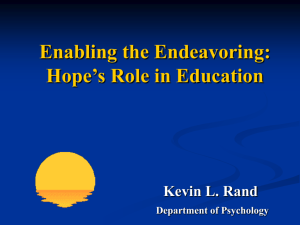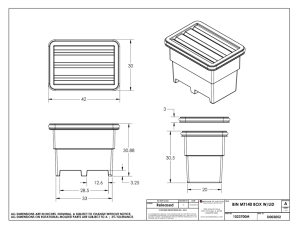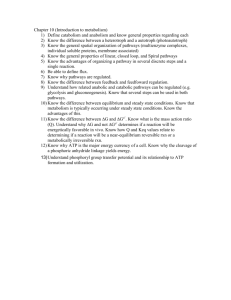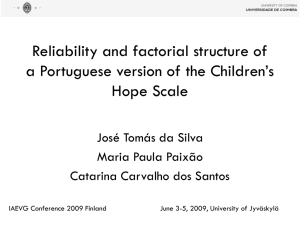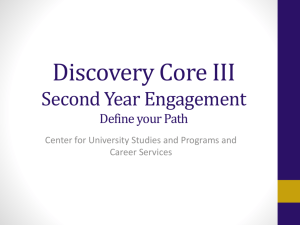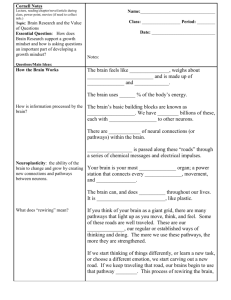Enabling the Endeavoring_The Roles of Hope and Goals in Service
advertisement
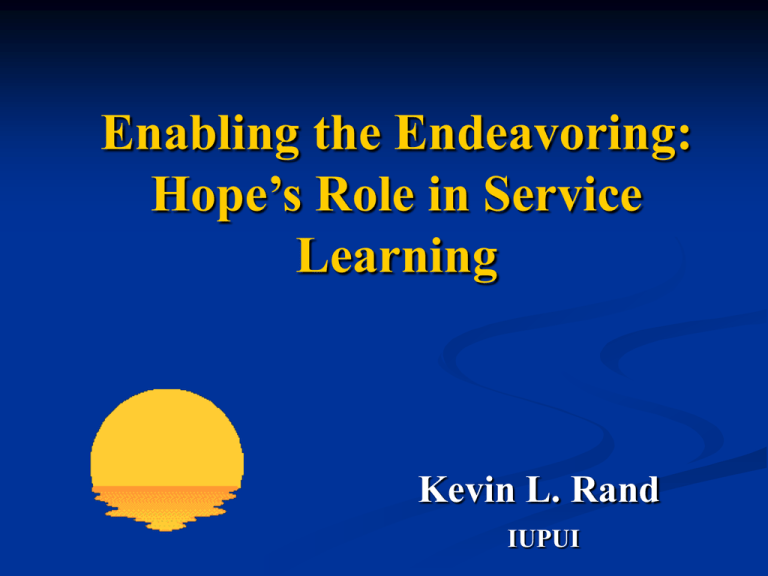
Enabling the Endeavoring: Hope’s Role in Service Learning Kevin L. Rand IUPUI Name the author… Each life converges to some centre Expressed or still; Exists in every human nature A goal Name the author… Each life converges to some centre Expressed or still; Exists in every human nature A goal -Emily Dickinson Overview: Where are we going? What is hope theory? How does hope relate to learning? What are the practical & research implications of hope theory for service learning? Research on Hope Higher hope → increased effort at tasks Higher hope → greater pain tolerance Higher hope → superior athletic performance above and beyond athletic ability Higher hope → better recovery from illness & injury Higher hope → better mental health Snyder’s (1994) Hope Theory Goals – the common thread to all purposive human behavior Pathways – ‘Waypower’ Agency – ‘Willpower’ Emotions – information feedback about goal pursuit Negative – blocked goal Positive – progress or accomplishment Goals • Mental Target • Some Probability of Reaching • Short & Long Term • Avoid vs. approach • Hierarchical Hierarchical Nature of Goals Abstract (“Be”) Ideal Self Be Healthy Exercise Diet Concrete (“Do”) Be Happy Run Swim Pathways • Perceived Ability to Produce Plans • Crucial When Encountering Blockages • Most Preferred & Alternate Routes Agency • Mental Determination • Self-talk: “I will do this…” • Channeling of Mental Energy to Appropriate Routes • Source can be internal and/or external Hope Measuring Hope Trait Hope Adult State Hope State Hope Scale (Snyder et al., 1991) Hope Scale (Snyder et al., 1996) Goal-specific Hope Goal-specific 2009) Hope Scale (Feldman et al., Adult Hope Scale HOW TRUE IS EACH STATEMENT OF YOU GENERALLY 1= Definitely False 4= Slightly False 5= Slightly True 8= Definitely True ___ 1. I can think of many way to get out of a jam. P ___ 2. There are lots of ways around any problem. P ___ 3. I can think of many ways to get the things in life that are important to me. P ___ 4. Even when others get discouraged, I know I can find a way to solve the problem. P ___ 5. I energetically pursue my goals. A ___ 6. My past experiences have prepared me well for my future. A ___ 7. I’ve been pretty successful in life. A ___ 8. I meet the goals that I set for myself. A Trait Hope Scale Data Average total score for adults is 48 High agency/pathways ≥ 26 Low agency/pathways ≤ 20 No gender differences Some ethnic/racial differences Hope & Learning: Theory Hope allows students to select, commit to, & work toward goals Hope engenders positive emotions, which foster learning & perseverance Broaden & build functions of positive emotions (Frederickson) Reduction in debilitating effects of anxiety Hope & Learning: Research Higher hope → more engaged & less disengaged coping with academic stressors Higher hope → less test anxiety Chang, 1998; Alexander & Onwuegbuzie, 2007 Onwuegbuzie, 1998; Snyder, 1999 Higher hope → academic success above and beyond intelligence Curry, Snyder, et al., 1997; Rand, 2009; Snyder, Hoza, et al., 1997; Snyder et al. (2002) 6-year prospective study of college students Hope measured first-semester of freshman year Higher-hope: Higher overall GPA (controlling for ACT) Lower dismissal rate Higher graduation rate Rand (2009) Semester-long prospective study of college students in psychology course Hope, optimism, & grade expectations measured at beginning of semester Higher-hope: Higher grade expectations → higher final grade Higher final grade (controlling for GPA) Optimism GPA .25 .87 .22 Goal Attitude .22 .87 Hope Class Grade .31 Predicted Grade .19 Rand, Martin, & Shea (2008) Semester-long prospective study of first-year law students Hope & optimism measured at beginning of semester Higher-hope: Higher semester GPA (controlling for undergraduate GPA & LSAT) LSAT .13 UGPA .38* .25* Hope .39* .38* Optimism Law School GPA .78 Life Satisfaction .56 Fostering Hopeful Education: General Ideas Optimizing Goals Fostering Pathways Fostering Agency Optimizing Goals Goals should be concrete & approach-oriented Set stretch goals for students Learning vs. performance goals “Understand the 4 types of experimental validity” “Get a 90% on my next psychology exam” Ironically, learning goals improve performance Avoid forced grade distributions Connect course goals to higher-order student goals/values Goal Clarification – remember Mr. Miyagi Goal Clarification Value Why? Goal How? Pathway Goal Clarification Student Value Why? Learning Goal Be able to influence outcomes of various situations Why? Be able to understand complex causal relationships across situations Why? Examine the relationship between social stigma & individual behavior Fostering Pathways Thinking Be explicit about what behaviors will lead to success 10 Pathways to successful learning “Generate 3 multiple-choice test questions each week” “Describe examples of stereotype thinking you observed during your service experience” Offer multiple ways to success Papers, tests, journals, activities Goal clarification Goal Clarification Learning Goal How? Pathway Goal Clarification Examine the relationship between social stigma & individual behavior How? Provide 20 hours of service at an agency serving severely mentally ill Fostering Agency: Class Structure Multiple methods of reinforcement Offer more than just grades Connect learning goals to other life domains Give meaning to learning goals Protects against satiation & burnout Depersonalize It’s grading system about their behaviors, not about them Failure is simply information that they should try something different Fostering Agency: Class Style Exude Energy Teach with enthusiasm & humor Energy is contagious Positive affect = better learning Be a Storyteller Humans are wired to learn & share stories Organize lecture as a narrative; use jokes, anecdotes Personalize the Class Learn & use student names Offer anecdotes from your own life Talk about things that are relevant to college students & their experiences Optimize Your Hope Have a circumscribed set of goals for the class Teach what excites you Cover more of what you are interested in & less of what you are not interested in Don’t assume responsibility for students’ goals Sometimes, less is more You can only lead the horses to water… Reframe student failure for yourself Failure, while unpleasant, is not inherently bad Service Learning: Some Hopeful Suggestions Begin the course by eliciting student values & priorities Have students rank-order their values/priorities What are your life priorities/values? What are your goals regarding your education? What is your most important value? Second? Pathfinding - ask students to create pathways between service learning and their most important values How might completing this course get you closer to what you want in life? Show the link between the self and others WE E W Service Learning Issue: Requiring Service May decrease motivation for future service (Batson et al., 1978; Deci & Ryan, 1985; Stukas, Snyder, & Clary, 1999) External control reduces intrinsic motivation Need for autonomy Effect is most pronounced for students not already motivated to engage in service “Why did I do it?” “Because I had to.” Service Learning Issue: Requiring Service Allow students & community representative to jointly define super-ordinate goals together Allow students to choose details and focus of service Have students reflect on pros and cons of required service Robbers Cave Study Reduces ambivalence Have students engage in pathfinding exercise connecting service learning experience to personal goals Pathfinding Exercise Abstract (“Be”) Be Happy Why? Make $ Connect with Others Why? Get a Job Why? Graduate Why? Concrete (“Do”) Service Learning Develop Diversity Skills Service Learning: Risks of Reflection Reflection exercises may erode perceptions of intrinsic altruism (Batson, Fultz, et al., 1987) Overly-sufficient justification Q: “Why did you really do this?” A: “For the grade.” Students who value self-knowledge at greatest risk Social learning theory of prosocial development 1) material reward 2) social reward “Here’s some candy!” “You’re a good girl/boy!” 3) self-reward “I’m a kind, caring, altruistic person.” Service Learning: Risks of Reflection Benefits of reflection may outweigh the costs Pennebaker’s work showing that writing involving causal attribution, insight, and self-reflection has mental and physical health benefits Tailor reflection & pathfinding exercises to student’s pre-course level of prosocial development As part of initial goals/values assessment, assess where students are in terms of prosocial development Materially focused Socially focused Intrinsically focused Pathfinding Exercise (Material) Abstract (“Be”) Ideal Self Make $ Get a Job Graduate Concrete (“Do”) Service Learning Pathfinding Exercise (Social) Abstract (“Be”) Ideal Self Relate to Others Develop Diversity Skills Concrete (“Do”) Service Learning Pathfinding Exercise (Intrinsic) Abstract (“Be”) Ideal Self Express Care for Others Concrete (“Do”) Service Learning Hope & Service Learning: Research Questions Is trait hope a moderator of the relationship between service learning and outcomes? Do students with higher levels of pathways thinking generate more connections between course goals and their personal goals? Do students with higher levels of agency participate more in the service learning? Do students with higher levels of agency thinking show greater increases in intention to remain civically active? Hope & Service Learning: Research Questions Is hope a mechanism by which service learning leads to outcomes? Does hope increase during service learning course? Do increases in hope predict intention to remain civically active? Do students with more concrete initial goals/values have less intention to remain active following the course? Also, does the proportion of material, social, and intrinsic goals change throughout the course? Thank You If you have questions about hope theory, please contact me: Kevin L. Rand klrand@iupui.edu Department of Psychology IUPUI 317-274-6771 State Hope Scale HOW TRUE IS EACH STATEMENT OF YOU RIGHT NOW 1= Definitely False 4= Slightly False 5= Slightly True 8= Definitely True ___ 1. If I should find myself in a jam, I could think of many ways to get out of it. P ___ 2. There are lots of ways around any problem that I am facing now. P ___ 3. I can think of many ways to reach my current goals. P ___ 4. At the present time, I am energetically pursuing my goals. A ___ 5. Right now I see myself as being pretty successful. A ___ 6. At this time, I am meeting the goals that I have set for myself. A Goal-Specific Hope Scale GOAL: HOW TRUE IS EACH STATEMENT OF YOU RIGHT NOW AS YOU THINK ABOUT THIS GOAL 1= Definitely False 4= Slightly False 5= Slightly True 8= Definitely True ___ 1. If I had problems achieving this goal, I could think of lots of ways around these problems. P ___ 2. Even when others get discouraged with similar goals, I know I can find a way to attain this goal. P ___ 3. I can think of many ways to achieve this goal. P ___ 4. I energetically pursue this goal. A ___ 5. My past experiences have prepared me well for trying to attain this goal. A ___ 6. I believe that I will meet this goal that I have set for myself. A Hope & Service Learning: Practical Applications Service Learning – teaching and learning strategy that integrates meaningful community service with instruction and reflection to enrich learning, teach civic responsibility, and strengthen communities Meaningful = superordinate goals for both student and community Civic responsibility = active citizenship Strengthen communities = help create “We” goals Goals of instructor: foster sense of caring for others, learning beyond classroom, active learning Pathways: pedagogy, active service, reflection Higher-Order Goals “Be” Goals Improve your creativity and problem-solving skills that can be used to achieve goals in other domains of your life. Become a more educated consumer of information and make better choices/decisions in getting the things you want. Understand how to use the scientific method and logic to answer questions and gain information to help you navigate life. Why? Learning Goal: Deepen Your Understanding of a Published Research Study How? Generate an alternative theory or hypothesis that would equally explain the findings of the study. Assuming the results of the study (and the theory they support) are true, how would you apply this knowledge to your own life? Lower-Order Goals “Do” Goals What questions do these results raise? Design a follow-up study to answer one or more of these questions.
